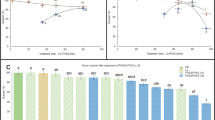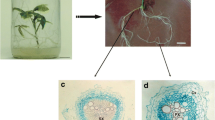Abstract
Huanglongbing disease (HLB), caused by Candidatus Liberobacter asiaticus, constitutes a most serious problem for the Chinese citrus industry. In this work, the use of vitrification-cryopreservation for eliminating Ca. L. asiaticus from naturally infected plants of several citrus species was investigated. Proliferating meristems were produced in vitro and excised tissue clumps were cryopreserved through vitrification using a plant vitrification solution 2. The health status of regenerated in vitro plants was checked by nested PCR. The putative HLB bacterial-free materials were subsequently re-tested after greenhouse acclimatization. Up to 98.1% of the plants obtained by cryopreservation were free from HLB bacterium, as compared with a sanitation rate of 25.3% yielded by conventional meristem tip culture. Light and electron microscopy observations of the meristem tips showed that the majority of the meristematic cells were injured either during the freezing/thawing step or during the osmotic dehydration step with plant vitrification solution 2. Only small areas of the meristematic dome survived the cryopreservation process, thereby increasing the probability of regenerating cells free of Ca. L. asiaticus. Large cells with big vacuoles and high water content, which are more likely to be infected by Ca. L. asiaticus, apparently cannot survive freezing in liquid nitrogen (LN). By contrast, small cells with dense cytoplasm located in the top layers of the meristem are more likely to escape invasion by Ca. L. asiaticus and can survive freezing in LN.






Similar content being viewed by others
Abbreviations
- BA:
-
N6-Benzyladenine
- DMSO:
-
Dimethylsulfoxide
- HLB:
-
Citrus Huanglongbing
- IBA:
-
Indole-3-butyric acid
- MT:
-
Murashge and Tucker
- PCR:
-
Polymerase chain reaction
- PVS2:
-
Plant vitrification solution 2, mixture of glycerol, ethylene glycol, DMSO and sucrose in MT medium
References
Bové JM (2006) Huanglongbing: a destructive newly-emerging century-old disease of citrus. J Plant Pathol 88:7–37
Brison M, Boucaud MT, Pierronnet A, Dosba F (1997) Effect of cryopreservation on the sanitary state of a cv. Prunus rootstock experimentally contaminated with Plum Pox Potyvirus, Plant Sci 123:189–196
Ding F, Yi GJ, Wang GP (2004) Research on the PCR and nested-PCR detection of Citrus Huanglongbing Pathogen. Acta Horticult Sinica 31(6):803–806
Ding F, Wang GP, Yi GJ (2005) Infection of wampee and lemon by the citrus Huanglongbing pathogen (Candidatus liberibacter asiaticus) in China. J Plant Pathol 87(3):207–212
Engelmann F (1997) In vitro conservation methods. In: Callow JA, Ford-Lloyd BV, Newbury HJ (eds) Biotechnology and plant genetic resources. CAB International, Oxford, pp. 119–161
Faccioli G, Marani F (1998) Virus elimination by meristem tip culture and tip micrografting. In: Hadid A, Khetarpal ARK, Koganezawa H (eds) Plant virus diseases control. American Phytopathological Society, St. Paul, pp. 346–380
Garnier M, Danel N, Bovè JM (1984) Aetiology of citrus greening disease. Ann Microbiol 135A:169–179
Goheen AC (1988) Diseases caused by viruses and virus-like agents. In: Pearson RC, Goheen AC (eds) Compendium of grape diseases, American Phytopathological Society, St. Paul, pp. 47–48
Haskins RH, Kartha KK (1980) Freeze preservation of pea meristems: cell survival. Can J Bot 58:833–840
Helliot B (1998) Croissance et Stabilite genetique des Vitroplants de Prunier Ferlenain Plumina (R) apres cryoconservation des meristemes. PhD thesis, Universite de Bordeaux 1, France
Helliot B, Panis B, Poumay Y, Swenen R., Lepoivre P, Frison E (2002) Cryopreservation for the elimination of cucumber mosaic and banana streak viruses from banana (Musa spp.). Plant Cell Rep 20:1117–1122
Helliot B, Swennen R, Poumay Y, Frison E, Lepoivre P, Panis B (2003) Ultrastructural changes associated with cryopreservation of banana (Musa spp.) highly proliferating meristems. Plant Cell Rep 21:690–698
Jagoueix S, Bovè JM, Garnier M (1994) The phloem-limited bacterium of greening disease is a member of the a-subdivision of the Proteobacteria. Int J syst Bacteriol 44:379–386
Jagoueix S, Bovè JM, Garnier M (1997) Comparison of the 16S/23S ribosomal intergenic region of ‘Candidatus liberobacter asiaticum’ and ‘Candidatus liberobacter africanum’, the two species associated with citrus Huanglongbing (greening) disease. Int J Syst Bacteriol 47:224–227
Leonhardt W, Wawrosch C.H, Auer A, Kopp B (1998) Monitoring of virus diseases in Austrian grapevine varieties and virus elimination using in vitro thermotherapy, Plant Cell Tissue Organ Cult 52:71–74
Luo ZD (1991) Preliminary report on the efficacy of heated tetracycline hydrochloride solution in treating citrus yellow shoot disease. J South China Agric Univ 12(2):38–42
Murashge T, Tucker DPH (1969) Growth factor requirements of citrus tissue culture. In: Chapman HD (eds) Proceedings on 1st international citrus symposium, vol 3. International society citriculture (ISC), River-side, pp 1155–1161
Reynolds ES (1963) The use of lead citrate at high pH as an electron opaque stain in electron microscopy. J Cell Biol 17:208–214
Sakai A, Kobayashi S, Oiyama I (1990) Cryopreservation of nucellar cells of navel orange (Citrus sinensis Obs. var. Brasiliensis tanaka) by vitrification. Plant Cell Rep 9:30–33
Song RL, Wu RJ, Ke C (1999) Elimination of main citrus virus and virus like disease by shoot tip grafting. Acta phytopathol sinica 29:275–279
Tannoury M, Vintejoux C (1997) Etudes cytologiques de bourgeonsd’oeillet (Dianthus caryophyllus L.) apres cryoconservation. Acta Bot Gall 144:107–118
Wang QC, Mawassi M, Li P, Gafny R, Sela I, Tanne E (2003) Elimination of grapevine virus A (HLB) by cryopreservation of in vitro-grown shoot tips of Vitis vinifera L. Plant Sci 165:321–327
Zhao XY, Qiu ZS, Su WF, Jiang YH (1981) Response of citrus huanglongbing to penicillin and tetracycline. South China Fruits (4):17
Zhao XY, Jiang YH, Li SL, Chen JZ, Ouyang L (1986) Indexing and exclusion of exocortis in Chinese citrus cultivars. Acta Horticult Sinica 13(2):91–94
Acknowledgments
This study was supported by China Ministry of Education (No. IRT0548), National Natural Science Foundation of China (No. 30700550), Key Plan of Guangdong province (No.2003B21601), and Key Plan of Hubei province (No.2006AA203B05). We especially thank Prof. G.P. Martelli, University of Bari, Italy and Prof. Tom hsiang, University of Guelph, Canada, for critical reading of the manuscript.
Author information
Authors and Affiliations
Corresponding authors
Additional information
Communicated by H. Judelson.
Rights and permissions
About this article
Cite this article
Ding, F., Jin, S., Hong, N. et al. Vitrification–cryopreservation, an efficient method for eliminating Candidatus Liberobacter asiaticus, the citrus Huanglongbing pathogen, from in vitro adult shoot tips. Plant Cell Rep 27, 241–250 (2008). https://doi.org/10.1007/s00299-007-0467-8
Received:
Revised:
Accepted:
Published:
Issue Date:
DOI: https://doi.org/10.1007/s00299-007-0467-8




